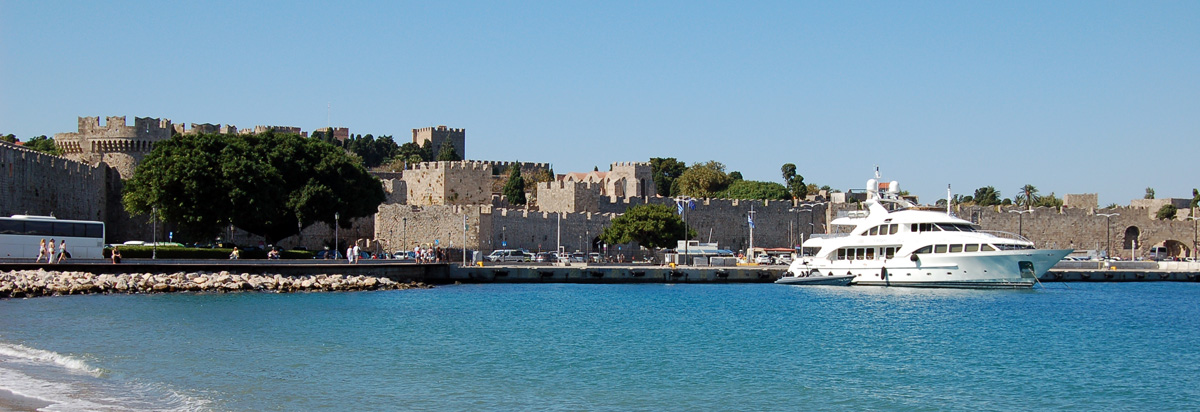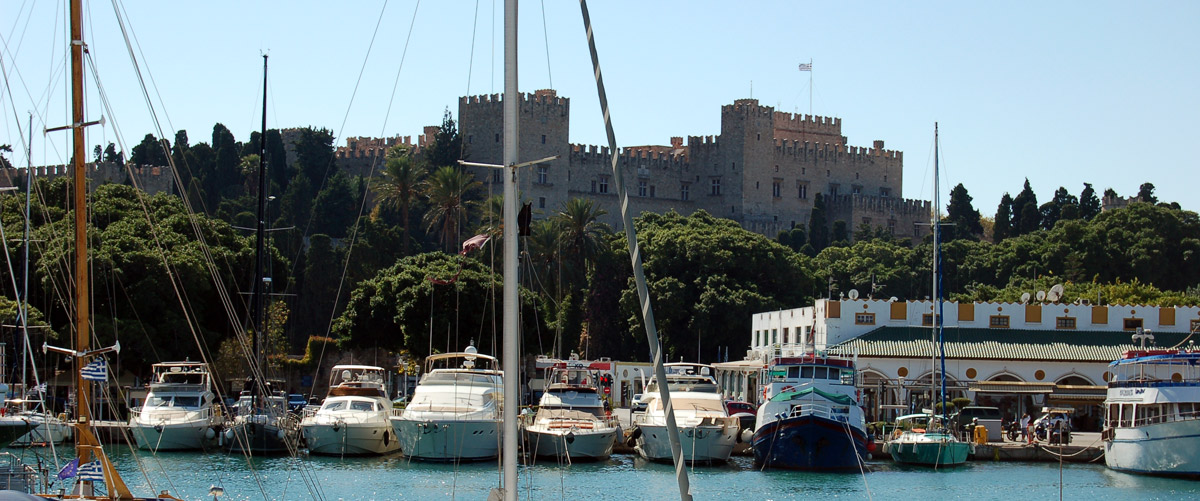
The geographer Strávon (1st century BC) recorded the island as “TELCHINÍS”, but the island had many other names. One version as to how it was called “RÓDOS” says that it was named after the daughter of Poseidónas and Amphitrítis, whose name was “Ródon” another says that it was named after the roses (“róda”) that the ancient coinage displayed as their emblem. During antiquity the island was devoted to the god Ílios (Helios – Sun) because of its year round sunlight. Findings have shown that the island has been inhabited from the Stone Age.
The first inhabitant of Ródos, according to the ancients, was Telchínes from Crete. During the Mycenean age it was inhabited by the Acheans (rich findings in Ialysós and Kámeiros) and then before the Trojan War, Dorians from the Pelopónnisos installed themselves on the island. Nine ships of the “haughty Rhodians” took part in the war. The three most ancient cities are Líndos, Ialysós and Kámeiros.
From early on the Rhodians founded colonies, not only in Asia Minor but also far to the West (Balearic Islands, Spain – city of Rodí, Italy – cities of Salapia / Siros / Sinaris, Sicily – city of Gela). Amongst the factors that contributed to island’s prosperity was the inclination of its people towards ship-building (when you are there, make sure to visit Ródos’ shipyard, to admire the masterpieces made by one of the last ship carpenters, Michális Nikoláou. Many foreigners learned by his side, especially Germans. Unfortunately the trade seem to be vanishing in Greece) as well as the Rhodians’ naval sense and its military fleet, which consisted of the famous type “fylakídas návs” (guard ships).
One of the most renowned men from this age (one of the seven in ancient Greece) was Kleóvoulos, who tyrannised over Líndos for 40 years (6th century BC). Many maxims have been attributed to him such as “Métron Áriston” (i.e. it is an excellent thing for somebody to keep a measure in his actions / behaviour), “filíkoon eínai kai mí polýloulon” (i.e. it is better to listen and not speak too much), “idonís krateín” (i.e. to be above pleasure), “gameín ek ton omoíon” (i.e. marry from your own social class because otherwise, as he explains, you don’t gain relatives but despots) and many others.
After the Persian wars the island became a member of the Athenian Allies, up until the end of the 5th century when they went over to the Spartans. In this century Diagóras was acclaimed in Ródos, the many times victor and Olympic champions, who died an old man overwhelmed by happiness on the shoulders of his three sons as they, Olympic champions themselves, crowned him with their garlands and paraded him through the stadium. Indeed one of his sons, Doriévs, instigated the coalition of three cities in one, namely Ródos towards the end of the 5th century BC. The new town was built amphitheatrically (with plans by the famous architect Ippódromos) with a 15km perimeter. It was one of the richest and most beautiful cities, decorated by over 3000 statues and many other public foundations. One such representative work can be seen in the famous “Níki tis Samothrákis” (by the famous Rhodian sculptor Pythokrítis), now decorating the Louvre (Paris)).
Towards the end of the 4th century BC the island was overtaken by the Great Alexandre and released at the end of the same century (after resistance to the occupation plans by Dimítrios the Besieger). The Rhodians celebrated their victory and as one of their dedications to the god Ílios, the Kolossós of Ródos (Colossus of Rhodes) was built, which was included in the seven wonders of the ancient world (bronze statue of the god Ílios 32m in height by the sculptor Háris from Líndos. Its legs were open and placed on either side of the harbour entrance, so the ships passed underneath).
During the Hellenistic years and the following Roman period the island prospered like no other Greek state. This is because of the size of its commerce, how far it extended into Asia Minor, its merchant fleet (its sailors were considered to be the best seafarers) as well as its political structure, which was a mixture of democracy and oligarchy. The Roman Cassius defeated the Rhodians at the beginning of the 1st century AD in a sea battle and having seized the city, slaughtered many men, pillaged the wealth and removed the 3000 statues, apart from the Colossus, to Rome.
Despite this Ródos cultivated its fortunes and remained one of the large centres of education and cultural development. Great men of the Roman Empire graduated from its schools, such as Tiberius, Skipion the African (2nd century BC), Mark Anthony (1st century BC), Cicerius and the poet Lucretius (1st century BC), Julius Caesar (1st century BC) and many others. Actually even Néro, having stripped Delphí, Olympía and Pérgamon bare of its works of art, respected the Rhodian state and did not harm it.
A massive earthquake in the middle of the 2nd century AD and the wild pillaging of the Goths in the middle of the 3rd century AD brought great blows to the island. During the Byzantine Age, Ródos became capital of the island provinces and began to thrive once again. In the middle of the 7th century AD Arabs attacked the island and having ravaged it, also destroyed the Colossus (900 camels were need to transfer its pieces). Up until the 10th century the Saracens and the Turks repeatedly raided the island. From the 11th century inwards the island begins to prosper again. Rhodian mercenaries took part in the 12th century Crusades, when King Richard the Lionheart (England) and King Philippe (France) passed through the island.
After the fall of Constantinople by the Franks (beginning of the 13th century) the island essentially belonged to Genoa up until they sold it to the Order of Johanna (beginning of the 14th century). Ródos flourished for almost two centuries. Castles, walls, public buildings and other such were erected, which can still be seen today.
At the beginning of the 16th century the island was taken by the Turks and was occupied by them for 4 centuries. In 1912 it was captured by the Italians, who built roads and buildings and generally organised the island. In 1947, Ródos, along with the rest of the Dodekánisa, was officially reunited with Mother Greece.

Climate: It is sweet, temperate and healthy, with hardly any humidity. It has a lot of sunlight all year round, and the meltemi help to cool down the summer heat.
Ródos town: The area of Mandráki is in the heart of the town. Two deer (Dama-dama) decorate the harbours entrance, on the sites where it is said that the feet of the Colossús stood.
The medieval fortification of the Knights dominates the town centre with the Palace of the Great Magistrate. It is amongst the most well kept cities. Indeed on display inside the Palace are permanent exhibits from ancient and medieval Ródos. There are many worthwhile places to visit. Do not forget to mount Ag. Stéfanos’ hill (or Monte Smith), which was the citadel of ancient Ródos.
Flavours: There are “pitaroúdia” which are essentially made from chick-peas and a very runny “skordaliá” (garlic paste) that is served on fresh beans but the king of tastes is the following dish, which I will describe for you: Rice, barley, goat – cock are sealed inside a ceramic dish and baked for 24 hours. As for wine, bear in mind that Ródos produces its own.





